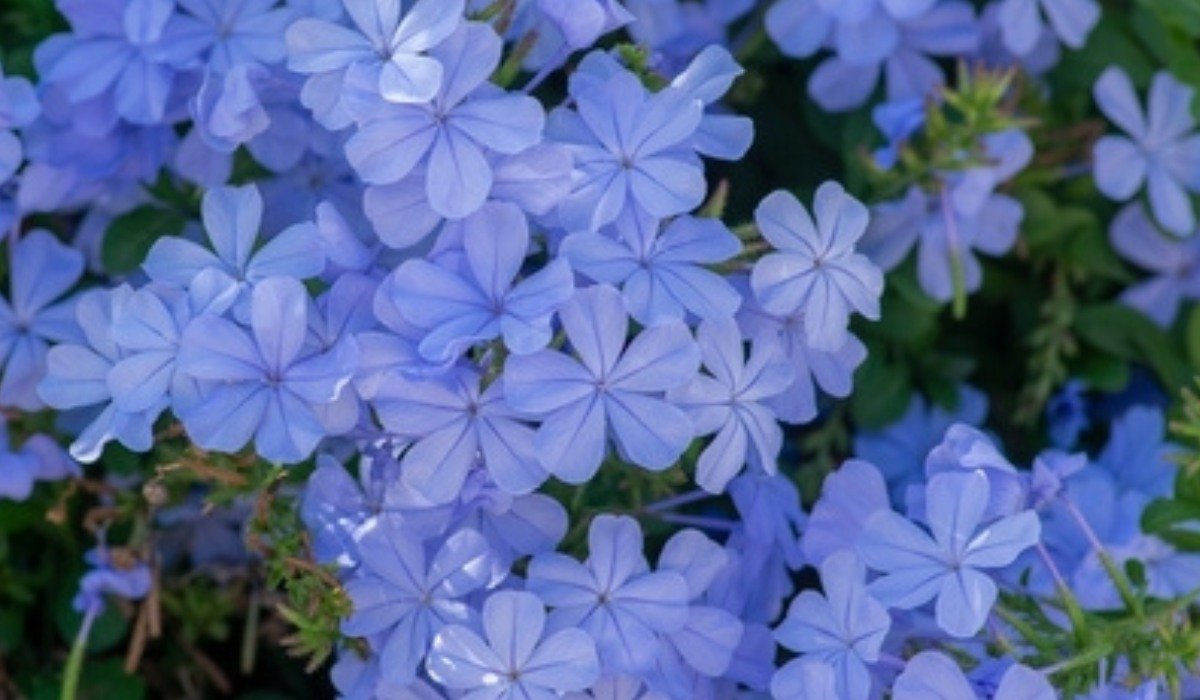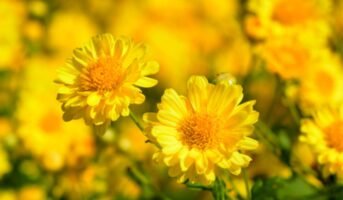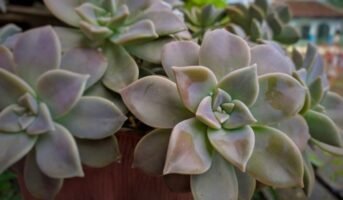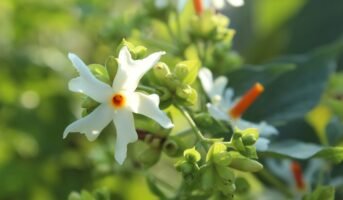Cape Plumbago (scientific name Plumbago Auriculata) can be cultivated as an annual or as a perennial in a container that is carried inside during the cooler months and placed in a bright, sunny room.
The white, blue, or pink flowers are tubular, 5-parted, and have spreading lobes. They are in a terminal cluster. It will bloom year-round in the ideal climate. Although it is really a shrub, it may be trained to behave like a vine with a little help.

Source: Pinterest
Plumbago Auriculata: Facts
| Common Name | Cape leadwort, cape plumbago |
| Family | Plumbaginaceae |
| Plant type | Conservatory, Evergreen |
| Sun Exposure | Full sun |
| Native | South Africa |
| Height | 3-10 ft in the wild |
| Flower | Blue |
See also: 21 best flowers for your garden
Plumbago Auriculata: Genus
The Plumbago Auriculata plant belongs to the Plumbago genus, a class of around 20 species of flowering plants in the Plumbaginaceae family. They grow in warm temperate to tropical areas around the world. The species includes herbaceous plants and shrubs.
Plumbago Auriculata: Native Habitat
The distribution of ranges across different regions of south Africa, including Cape, Eastern Cape, Mpumalanga, the Free State and North West Province. It shares a habitat with Tecomaria capensis, the Cape Honeysuckle.
Plumbago Auriculata: Characteristics
Mature Height
When fully grown, the plant can reach a height of around three to ten feet. However, it can pruned to grow as vine.
Leaves
The plant leaves have a thin texture with small gland dots. The leaf stalk is winged around the base, and holds the stem. Leaves are oblong in shape and light yellowish green in colour. The leaves of the Plumbago species have spiral arrangement with tapered base and hairy margin.
Growth rate
Plumbago species are known to be fast-growing plants. It takes about six months to one year for attaining its mature size. If unsupported, it grows into a expansive, mounding bush.
Fruit
Plumbagos will also produces poisonous fruit covered in sharp barbs.
Companion plant
Plumbago plants can be placed near other plants, which can attract beneficial pollinators such as butterflies, birds, and bees.
Plumbago Auriculata: How to grow?
- It is not difficult to plant plumbago. If you’re going to plant it in the ground, choose a location that has the right growing conditions.
- Dig a hole large enough to accommodate the plant’s root system. When planting, incorporate compost into the soil.
- Fill the hole with quality, well-draining soil and replant the plant (if possible). After planting, make sure to water the shrub.
- If you’re growing the plumbago plant in a container, make sure it’s big enough to support the root system.
- Small pebbles can also be added to help with drainage and keep the plant from becoming soggy. Fill the planter halfway with soil, then place the plant and finish filling the planter with soil.
- You can propagate plumbago plants once they have established themselves. The most popular technique of propagation is cuttings.
- Remove a five-inch cutting from the adult plant to begin the propagation process. This will be the plant’s wooded area.
- Place the cutting in a soil-filled pot. Spritz the pot with water on a regular basis. Take care not to overwater.
- You want the soil to stay moist but not soggy. Because of the warmth in most areas, it is best to propagate during the summer months. It should take about a month for the cutting to form roots.
Plumbago Auriculata: When to plant?
Plumbago must be planted in the early spring after the last frost has noticeably passed.
See also: What is mint and what are its numerous benefits?
Plumbago Auriculata: Maintenance
These bushes are perfect for growing in containers. Make sure your shrub has enough area to grow, and use decent potting soil with a neutral pH. Enjoy it outside while the weather is nice. Indoor, it will grow two to three feet tall if you water it regularly and fertilise it every spring. In the winter, water indoor plants just occasionally. Cut back in late winter if treating it as a perennial to promote new growth for the next season. Additionally, it can be pruned back in the winter and kept in a cold, dark location.
Sun Tolerance
Plumbago Auriculata grows well in bright sunlight. However, it can withstand shade but it can impact the production of flowers. Hence, it must be placed in an area that receives ample sunlight.
Cold Tolerance
Plumbago Auriculata is a perennial shrub, which stops flowering in winters. Freezing temperatures may not be favourable for the plant. Hence, it becomes important to care for the plant, which involves cutting it back and placing it in a closed area to protect it against frost and cold weather.
Water requirements
- Even though it is resistant to drought, you should provide the necessary water. When you’re not sure if your system requires more water, use the knuckle test.
- Insert your finger into the soil near your plant. If the soil is moist to your first knuckle, the plant doesn’t really require any additional watering.
- If the soil is dry with your first knuckle, it’s time to give your plant a good soak. This means that you water for extended periods of time on fewer days of the week. This moistens the soil down to the plant’s roots and supplies a sufficient supply of water.
- When the watering is under control, it is time to fertilise the plant. Plumbago does not require regular fertilisation.
Fertiliser requirements
Plumbago does not require regular fertilisation. In fact, you can fertilise the plant once in the spring, and it should not require fertilisation again for the rest of the growing season.
Repotting
If you’re growing your plumbago in a container, you should repot it every third year. Do this in early spring, when the plant is waking up. If spring is too busy for you and you miss your window, you can repot the plant in the fall when it is dormant.
Plumbago auriculata: Is it a houseplant?
Cape plumbago flourishes when placed in plants and containers. The plant’s sprawling branches and blossoms will spill over the side of pots, which can be used to great decorative advantage. Use a container with a drainage hole on the bottom since the cape plumbago needs light, sandy soil that is well-draining. Once established, the shrub can withstand brief periods of neglect and is moderately drought tolerant.

Source: Pinterest
Wildlife garden
Given that it draws a variety of butterflies and serves as food for the common blue butterfly’s larvae, this plant is a great addition to a butterfly garden. Flowers last a long time and continue to bloom all through the spring and summer. Because butterflies are drawn to flowers, it is important to grow cape plumbago in full sunlight because planting it in the partial shade would result in less flowering. Robins and other birds are drawn to Cape Plumbago as well because of the dense vegetation’s shelter.
Plumbago Auriculata: Toxicity
Plumbago plants may be toxic to humans and animals. It is recommended to keep the plant away from pets. When skin comes in contact with the plant, it may cause dermatitis in humans.
Plumbago Auriculata: Uses
- Plumbagin, an antifungal compound found in this helpful herb, supports the body cells’ ability to fight off numerous infections.
- It functions well as a heart tonic as well. Due to its cardioprotective properties, this herb shields our hearts from the risk of certain illnesses.
- Additionally, the plant possesses qualities that support your body cells’ ability to combat malignant cells.
- Additionally, it works well for curing excruciating toothaches.
- It is an anti-haemorrhagic substance that makes it simple to halt heavy bleeding. Additionally, it has qualities that can combat malignant cells.
- Indigestion and hyperacidity can both be effectively treated with root extract.
See also: What is mint and what are its numerous benefits?
FAQs
Do we need to wear gloves while handling plumbago auriculata?
When touching the plant, wear gloves because it might cause contact dermatitis.
Is the plant poisonous?
Plumbago auriculata causes skin irritation, eye irritation, and stomach distress and is dangerous if consumed. Toxins are also absorbed via the skin.
Housing News Desk is the news desk of leading online real estate portal, Housing.com. Housing News Desk focuses on a variety of topics such as real estate laws, taxes, current news, property trends, home loans, rentals, décor, green homes, home improvement, etc. The main objective of the news desk, is to cover the real estate sector from the perspective of providing information that is useful to the end-user.
Facebook: https://www.facebook.com/housing.com/
Twitter: https://twitter.com/Housing
Email: [email protected]











